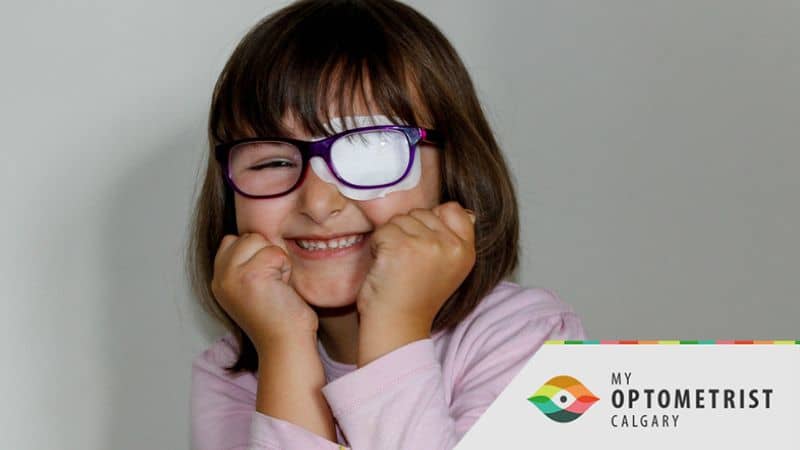
Lazy eye, also known as amblyopia, is when one of the eyes has reduced vision due to abnormal development, which causes the eye to wander. Because the vision within one eye is weaker, it is difficult for the brain to process two images where one image is sharp and clear and the other is blurry. Instead of trying to reconcile these images, the brain will ignore signals from the weaker eye. A lazy eye will typically begin to develop anytime between birth and age 7. There are some ways that optometrists treat lazy eyes, several of which are non-invasive or require little to no medication, although these are also potential options. Here are some treatments for lazy eye that you may want to consider for your child.
Lazy Eye Treatment Options
Eye Patches
This has been the most popular method for correcting lazy eye for many years. Since the brain is only acknowledging the dominant eye, an eyepatch will be placed over the dominant eye so that only the weak eye is available for use. This forces the brain to pay attention to the weak eye and to gradually resume vision in this eye. Eye patches aren’t worn constantly, but they are typically worn for at least 6 hours a day, and wearing them for less time may impact the effectiveness of the treatment. Eye patches can be placed directly over the eye with a sticky substance around the outer edge (sort of like a bandaid), or the child can wear glasses with a patch over one of the lenses, depending on your child’s needs and your optometrist's recommendations.
Bangerter Filter
This filter functions on the same principle as the eye patch but to a lesser degree. Instead of completely blocking out the vision of one eye, the stronger eye is given a prescription that blurs the vision. This way the stronger eye is not perceived as stronger, and the weaker eye will work harder to make up for the vision lacking in the blurred eye.
Corrective Lenses
Sometimes correcting your child’s vision is all it takes to reduce lazy eye. If the eye is given the tools so that it can see properly, neither eye is registered as the weak eye and it may begin to function normally.
Eyedrops
There is a medication called atropine that functions similarly to the Bangerter filter. Atropine will temporarily blur the vision of the stronger eye so that the weaker eye must be used. This is a good option for children who struggle to wear the eye patch or eyeglasses.
Surgery
This option is not particularly common and it is not recommended for every child with lazy eye. Sometimes the weaker eye has a physical impairment that is limiting vision, for example, cataracts or a drooping eyelid. Surgery can be used to remove the cataract or to alter the eyelid so that vision can be improved.
Learn more about lazy eye by reading Things You Might Not Know About Lazy Eye.
Treat Lazy Eye At My Optometry In Calgary Or Three Hills
If your child has a lazy eye, there are ways to correct it. At My Optometrist in Calgary and Three Hills, our experienced optometrists work with you to determine the best lazy eye treatment for your child. By scheduling a child’s eye exam, your child can have their lazy eye diagnosed and start a treatment plan, while also receiving an exam of their eye health to check for any other conditions. To book an eye exam with one of our eye doctors, contact My Optometrist at one of our three locations at Health First in SE Calgary, Sunridge in NE Calgary, or Three Hills, AB. You can also call us or fill out the online contact form.
FAQ
Q: What are the chances of getting amblyopia?
A: This condition is very common in children, and symptoms may be difficult to distinguish from other visual conditions. At least 2-3 out of every 100 children are affected by lazy eye. It should be treated in early childhood, otherwise the condition persists into adulthood. If not treated early, the eyes may never achieve normal visual acuity, even with the assistance of contacts or prescribed glasses.
Q: What is the difference between lazy eyes and crossed eyes?
A: Lazy eye (amblyopia) is caused by the vision in one eye being weaker than the other, which makes the eye fall out of use and wander. Crossed eye (strabismus), is when the eyes do not line up. Since the eyes are not aligned and may be sending two different images to the brain, the brain may choose to ignore one of the eyes, causing crossed eye to result in lazy eye. Learn more about the relationship between these conditions by reading 3 Possible Causes Of Lazy Eye.
Q: How do you know if your child has a lazy eye?
A: During an eye exam, your optometrist will complete a series of simple, but effective, eye tests to confirm the suspicion of lazy eye. These tests will help to identify and detect eye strengths, weaknesses, and brain-eye connections.